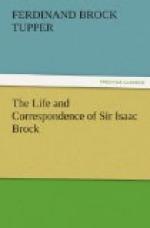[Footnote 107: For council of condolence, see Appendix A, Section 1, No. 6.]
[Footnote 108: The officers of the 49th, after his death, instructed the regimental agent in London to procure them a likeness of Sir Isaac Brock, that it might be placed in their mess-room, and allotted a handsome sum for this purpose. The agent applied to the family for a copy, but unfortunately they possessed no good likeness of the general.]
[Footnote 109: The salary attached to the civil government of Upper Canada was increased, we believe, shortly before his death to L3,000 a year.]
[Footnote 110: By an official return, it appears that this monument cost L1,575 sterling. For inscription, &c, see Appendix A, Section 1, No. 7.]
[Footnote 111: See Appendix A, Section 1, No. 8.]
[Footnote 112: For the address, see Appendix A, Section 1, No. 9.]
[Footnote 113: This column cost nearly L3,000.]
[Footnote 114: For the details of the re-interment, see Appendix A, Section 1, No. 10.]
[Footnote 115: It was a Tuscan column on a rustic pedestal, with a pedestal for a statue; the diameter of the base of the column was seventeen feet six inches, and the abacus of the capital was surrounded with an iron railing. The centre shaft, containing the spiral wooden staircase, was ten feet in diameter.]
[Footnote 116: We speak in the past tense, because the column, as will be seen in the sequel, was so much injured in 1840 as to require its reconstruction.]
[Footnote 117: Howison’s Sketches of Upper Canada. London, 1821.]
CHAPTER XV.
Sir Isaac Brock was succeeded in his civil and military commands in Upper Canada by Major-General Sheaffe, who was created a baronet for the dearly bought victory of Queenstown. After the battle, he paroled General Wadsworth and some of the principal American officers, the remainder proceeding to Quebec. Among the prisoners, 23 were found to be deserters from English regiments, and British born subjects; and they were sent to England for trial as traitors. This caused a retaliation upon British prisoners in the United States, and an equal number were put by the American government into close confinement as hostages for the security of the traitors.
On the 18th of October, General Smyth assumed the command at Niagara, and applied to the British general for an armistice; and notwithstanding the well-known prejudicial effect of the former one proposed by Sir George Prevost, it was agreed to by Major-General Sheaffe![118] This unaccountable proceeding, as might easily have been foreseen, proved of material detriment to the British on Lake Erie, as the Americans availed themselves of so favorable an occasion to forward their naval stores unmolested from Black Rock to Presqu’ile by water, which they could not otherwise have effected, but with immense trouble and expense by land, and equipped at leisure the fleet which afterwards wrested from us the command of that lake. When the enemy was prepared for a third invasion of Upper Canada, General Smyth did not fail to give the thirty hours notice required for the cessation of the armistice, which terminated on the 20th of November.




